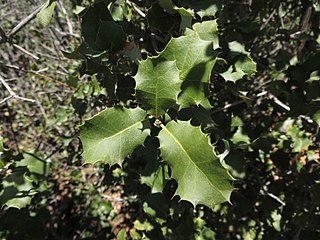
Live oak or evergreen oak is any of a number of oaks in several different sections of the genus Quercus that share the characteristic of evergreen foliage. These oaks are generally not more closely related to each other than they are to other oaks. When the term live oak is used in a specific rather than general sense, it most commonly refers to the group of species under Quercus sect. Virentes, which includes the southern live oak, the first species so named, and an icon of the Old South.

Quercus douglasii, known as blue oak, is a species of oak endemic to California, common in the Coast Ranges and the foothills of the Sierra Nevada. It is California's most drought-tolerant deciduous oak, and is a dominant species in the blue oak woodland ecosystem. It is occasionally known as mountain oak and iron oak.

California mixed evergreen forest is a plant community found in the mountain ranges of California and southwestern Oregon.

The western toad is a large toad species, between 5.6 and 13 cm long, native to western North America. A. boreas is frequently encountered during the wet season on roads, or near water at other times. It can jump a considerable distance for a toad. Breeding occurs between March and July in mountainous areas, and as early as January in lower-elevation regions. The female lays up to 17,000 eggs stuck together in strings that adhere to vegetation and other objects along water edges.

Adelpha californica, the California sister, is a species of butterfly in the family Nymphalidae. They are common in California, but can also be found in western Nevada and Oregon, as well as in northern Baja California. The upper surfaces of their wings are dark brown to black with wide cream white bands dissecting both wings and two orange patches near the tips of the forewings. The underside is variously colored with browns, blue, orange, and white. A. californica is unpalatable to predators and is part of a large mimicry complex.

The eastern tailed-blue or eastern tailed blue, also known as Everes comyntas, is a common butterfly of eastern North America. It is a small butterfly that is distinguished from other blues in its range by the small thin tail.

Quercus chrysolepis, commonly termed canyon live oak, canyon oak, golden cup oak or maul oak, is a North American species of evergreen oak. Its leaves are a glossy dark green on the upper surface with prominent spines; a further identification arises from the leaves of canyon live oak being geometrically flat.

The Rogue River–Siskiyou National Forest is a United States National Forest in the U.S. states of Oregon and California. The formerly separate Rogue River and Siskiyou National Forests were administratively combined in 2004. Now, the Rogue River–Siskiyou National Forest ranges from the crest of the Cascade Range west into the Siskiyou Mountains, covering almost 1.8 million acres (7,300 km2). Forest headquarters are located in Medford, Oregon.

Habrodais is a Nearctic genus of butterflies in the family Lycaenidae.

Quercus vacciniifolia, the huckleberry oak, is a member of the Protobalanus section of genus Quercus. It has evergreen foliage, short styles, very bitter acorns that mature in 18 months, and a woolly acorn shell interior.

Catocala ophelia is a moth of the family Erebidae. It is found in the dry forests of Arizona, California and south-western Oregon.
The Mediterranean California lower montane black oak–conifer forest is a major forest association and ecosystem of the California mixed evergreen forest bioregion in certain mountain ranges in California and southern Oregon in the Western United States; and Baja California in northwest Mexico.

Quercus palmeri is a species of oak known by the common name Palmer oak, or Palmer's oak. It is native to California, Baja California, Southern Nevada, and in Arizona through the transition zone to the eastern Mogollon Rim, where it grows in canyons, mountain slopes, washes, and other dry habitats.

Cameraria leucothorax is a moth of the family Gracillariidae. It is known from California and Oregon in the United States.

Cameraria agrifoliella is a moth of the family Gracillariidae. It is known from California, United States, and British Columbia, Canada.

Cameraria conglomeratella is a moth of the family Gracillariidae. It is known from Illinois, Kentucky, Texas, California, Florida, Georgia, Maryland, New Jersey, Ohio and Virginia in the United States.
Acrocercops insulariella is a moth of the family Gracillariidae. It is known from the United States (California).
Stilbosis dulcedo is a moth in the family Cosmopterigidae. It was described by Ronald W. Hodges in 1964. It is found in North America, where it has been recorded from California and Arizona.















